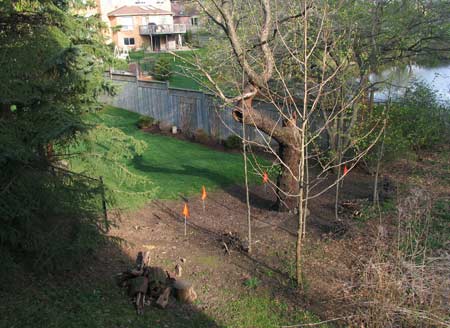 |
|
 |
|
Naturalization of my Property |
|
Spring 2005
(Page 1)
|
|
Back Yard
|
| Well, this spring has been a time of balancing, of
adjusting. |
| |
|
 |
There has been old Common Buckthorn hedge along the west side of the
property, that had seen better days. It is barely visible in this
photo (taken in July 2004), BEHIND the trees and the chair. Common
Buckthorn is not a very well-behaved shrub. It gets rather unruly,
has wicked thorns, is very invasive, and doesn't even have pretty
flowers to redeem itself!
This particular hedge had gradually widened over the years, and
now there were a lot of dead plants in the middle. It was a good 10
feet thick! The birds liked it to shelter in, and the squirrels
liked it as an aboveground pathway, but that's probably about all
the nice things I can say about it. Oh, one more thing -- it did
indeed act as a very effective screen between the two properties.
However, it was adversely impacting the growth of the Colorado
Spruce to the left, shown here. And my neighbour, who likes a very
neat and tidy yard, was quite happy to see the end of the buckthorn. |
|
|
|
|
 |
So we did it. We cut the whole thing down this spring, in mid-April,
before the leaves were out (easier to dispose it of that way).
This is the "after cutting" photo. Yeah, it looks kind of bare.
We had of course already decided what to plant in place of the
Buckthorn hedge -- Colorado Spruces along the property line.
Take note of the Black Cherry tree that's in the middle of the
photo. We found this spring that this tree was about 90% dead. I'll
talk more about this tree soon... |
|
|
 |
This is after web cleaned up the cut buckthorn. The flags are the
proposed locations of the Colorado Spruces. A note about our
choice ... Although Colorado Spruce is not native to Ontario, they
are also not invasive. I chose them because they grow reasonably
quickly, are very hardy here, and fill in very well, creating a nice
screen between the properties. A native spruce, such as White
Spruce, doesn't grow as thick as Colorado Spruce.
So ... this is one of those compromises I have mentioned
previously. |
|
 |
Here we have decided on planting 4
Colorado Spruces and have dug holes for them. We eventually got
2 trees, but larger than we originally decided on. We have cut
down the Black Cherry, as it was 90% dead, with VERY little
growth coming out this year (very few leaves). Since we were
going to be planting new trees under it we decided to cut it
down before planting them, to avoid damage to the new ones.
We left the stump (as you can see here) as a roost for birds
and squirrels. Plus it adds a bit of character to the scene. |
|
 |
And here's the Colorado Spruce
trees. One is hidden behind the leaves of the Cucumber Magnolia
in this photo. We eventually decided on two 10-foot trees,
rather than four 6-foot ones. |
|
 |
A different view of the new
Spruces. That's my neighbour's deck. Yes, it's very open for
now, but the Spruces will grow in over the next few years. Also,
the lack of hedge makes the two properties look larger. |
|
 |
Then we had to decide what to do
with the bare space where the Buckthorn hedge used to be. This
photo shows that bare space ... about half of what you see here
was inside the hedge. However, the part inside the hedge
extended beyond the photo, to the left! In the end, we decided
to plant grass (yes, grass!) for the time being. It's quick,
blends in well with the neighbour's yard (with naturalization
good neighbour relations can be important), and will look nice.
Neither ourselves or the neighbour use pesticides or herbicides.
Later on we can easily remove the grass if we want to do
something else with this area.
It's all about balance. |
|
| |
|
Previous
Next
|
|
|
|